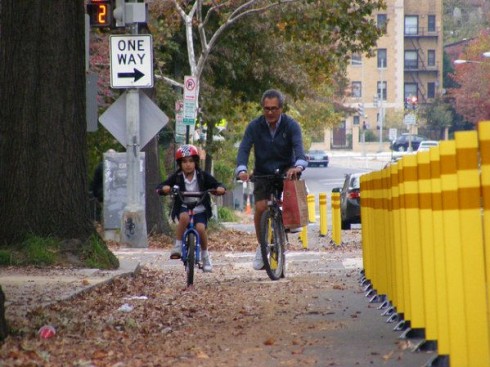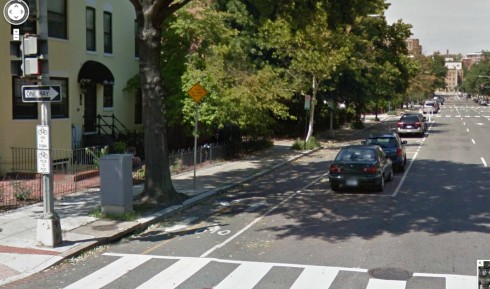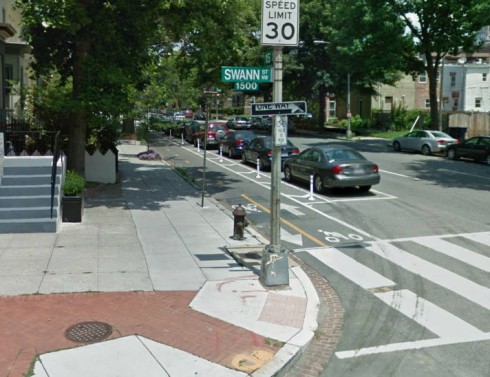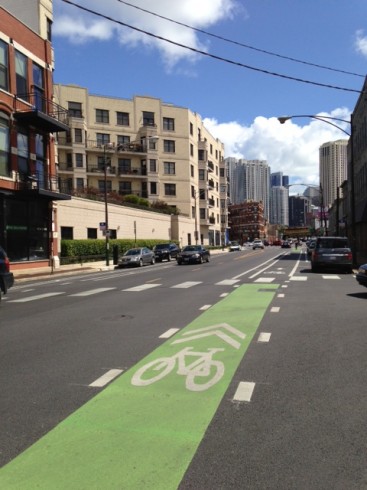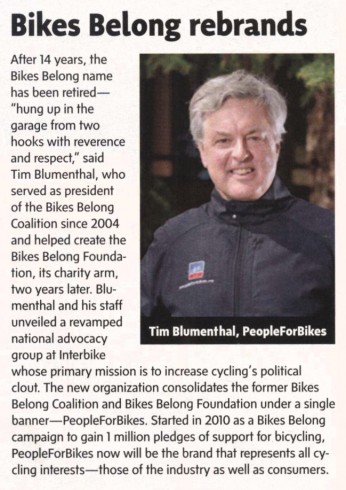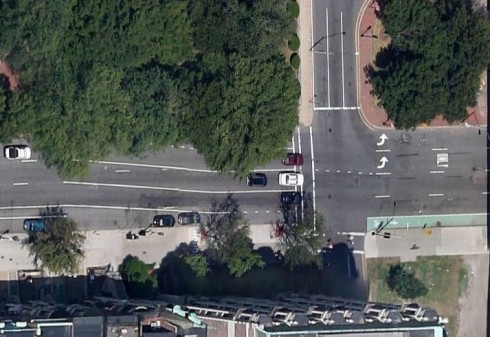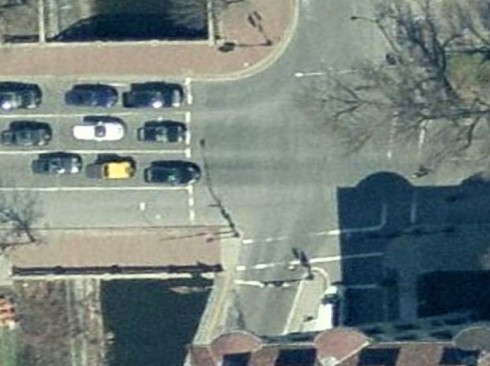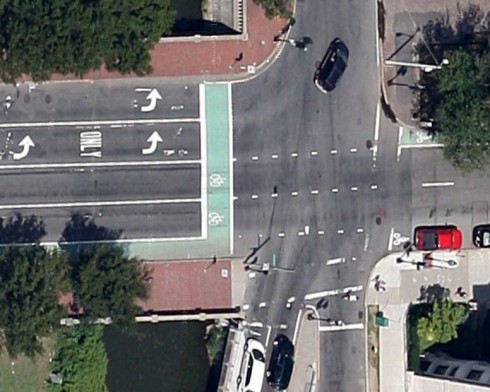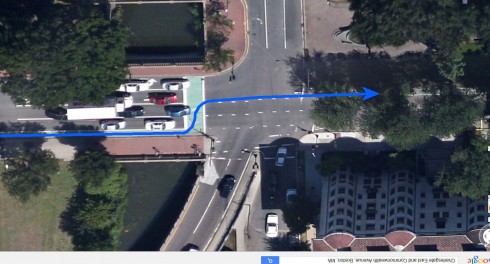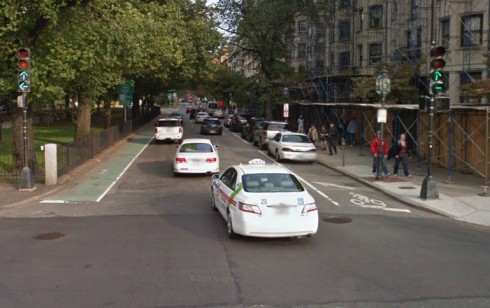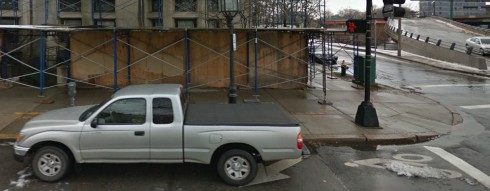The cyclists in the photo below are riding through piles of leaves where they can’t see the road surface. The man has a shopping bag hanging from the handlebar where it can swing into the spokes of the front wheel. The shopping bag and possible hazards under the leaves carry the risk of a front-wheel-stopping crash, with the cyclist pivoting forward and landing on his head.
The photo appeared in Momentum Magazine, and was provided by the Green Lane Project, an organization funded by bicycle manufacturers and which promotes the construction of barrier-separated on-street bikeways. I commented on the photo in an earlier post, and said that I’d return to the topic, because I recognized the location. So, here I am.
It is 15th Street and T street in Washington, DC, USA. Here’s a Google Street View from a couple of years ago. Some different traffic signs have been installed since then, and yellow flex posts have replaced white ones, but the tree with white bark is unmistakable. The pinkish building in the background of both images is three blocks away, at W street.
The cyclists’ riding side by side gives the impression that the bikeway is one-way, but actually it is two-way, as the Street View photo shows. Leaves and trash cover the lane lines in the Green Lane photo.
What is it really like to ride this bikeway? In the video embedded below, my friend Keri Caffrey rides in the same direction as the cyclists in the Green Lane photo, also at a time of light traffic. Keri reaches T street at 1:11 in the video. She rides all the way down to H street, and obeys the traffic signals.
About half the time, she is waiting for the signals, and so her average travel speed is 4.5 miles per hour. Most of this street is one-way, the traffic lights are timed for traffic in the other direction, and cyclists have only a short interval to cross legally, because turning traffic has a dedicated signal phase. Nonetheless, Keri encounters some turning and crossing conflicts. Other cyclists in the video can’t be bothered to wait for the signals.
15th street southbound from Keri Caffrey on Vimeo.
Why are the leaves in the street? Washington, DC has information on leaf collection, instructing residents to place leaves in treeboxes (between sidewalk and curb) rather than in the street, and acknowledging problems with leaf pickup due to weather conditions. As the trees are at the curb, nearly half the leaves fall directly into the street. The sidewalk extends all the way to the curb and there is very little space around trees to store the leaves they drop. Without a barrier-separated bikeway, nobody would have to use space next to the curb as travel space.
The message of the Momentum Magazine article is “better biking,” and by implication, safe cycling even for children and novice cyclists, thanks to barrier-separated bikeways. One of the cyclists in the Green Lane Project photo is a young child, who, to be sure, wouldn’t be safe riding on streets with fast or heavy motor traffic. The other cyclist is an adult, but his choice to hang a bag over the handlebar speaks volumes about his skill level.
Or was that his own choice? Did the cyclists show up by chance — at such a low-traffic time, and near the end of the bikeway where traffic is lightest? Did the photographer lurk, waiting and waiting, holding a camera with a long telephoto lens, standing in the middle of the bikeway? A photographer could wait for hours before suitable subjects showed up.
I suspect strongly that the photo was staged, and the cyclists were recruited for the photo shoot. The Green Lane Project would then carry some responsibility for their actions, and not only for the choice of the photo.
As is typical of Green Lane Project work, the photo is carefully framed to, well, create an impression. It is said that the camera doesn’t lie, but on the other hand, perspective can play tricks. What looks like a continuous wall at the right side of the photo is actually a line of widely spaced flexible barrier posts, as is clear in the Street View image below, which also shows a treebox on the sidewalk. It is filled to the brim, though the photo was taken in midsummer.
The video of one of my own rides on this street is posted below. I am riding northbound — in the opposite direction of Keri’s ride in the earlier video — and Keri is behind me, shooting video with her helmet camera. At 3:37, a pedestrian walks out between flex posts into my path. At 4:40, there’s a conflict with oncoming bicycle traffic. Both these situations required me to slow abruptly. There are several left-hook conflicts and a couple of oncoming right-cross threats.
We cross T street at 11:47 in the video. Total time from H street to V street was 14 minutes, 31 seconds for an average speed of 5.1 miles per hour. Waiting time was 5 minutes 21 seconds. The traffic light timing was more favorable, but this direction is slightly uphill.
15th Street Cycletrack at Rush Hour from Keri Caffrey on Vimeo.
While young children and novice cyclists aren’t safe on a busy street, it’s certainly fair to ask whether they are safe on this bikeway, considering that it wasn’t safe for me.
During rush hour, major intersections on the bikeway descend into chaos, as shown in another of Keri Caffrey’s videos.
Are there better alternatives? Yes, in education and in infrastructure choices, among other things, but they require a bolder, broader, more knowledgeable and more flexible approach than we see here.
One more comment about the cyclists in the video: as I’ve made clear elsewhere, I strongly advocate helmet use, but I don’t promote mandatory helmet laws. Lacking near-universal acceptance of helmet use, such laws can do more harm than good, in my opinion. I give my reasons for that in another article.
On the other hand, as my good friend Sheldon Brown liked to say, a parent who puts a helmet on his child but doesn’t wear one himself is offering the example “do as I say, not as I do,” and unnecessarily risks leaving the child an orphan.
Finally: As I noted in my previous post, someone at Momentum Magazine deleted comments I left on its blog. The comments were as polite as these, but much shorter. The author of the Momentum Magazine article, Managing Editor Duncan Hurd, commented on my previous post, suggesting a dialog by e-mail. I responded saying that I welcomed a dialog. The only more recent communication I have had from him is a second comment describing my observations as “concern trolling.”
My friend Khalil Spencer posted comments on the Momentum Magazine article later, and those too were deleted. Khalil has posted on his own blog about that. His post makes good reading.

